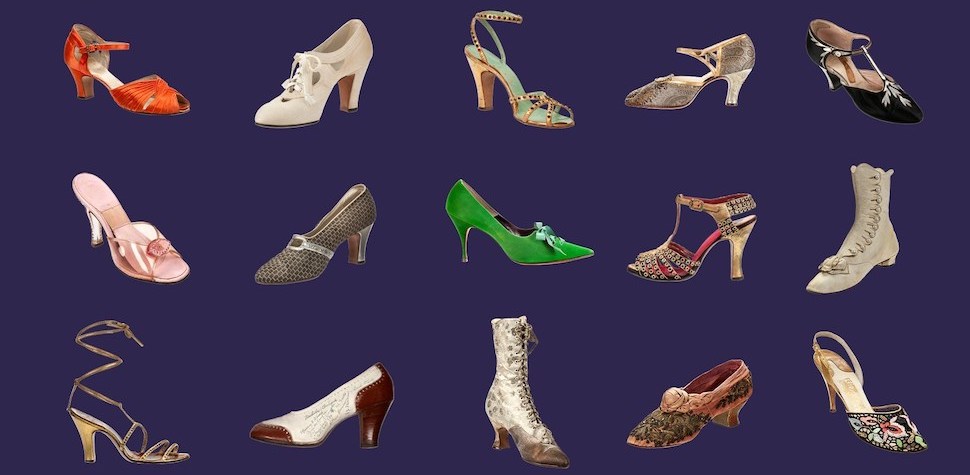The Dallas Holocaust and Human Rights Museum has announced a new special exhibition, “Walk this Way: Footwear from the Stuart Weitzman Collection of Historic Shoes.” Organized by the New York Historical Society, the exhibit will be on view until July 14.
The museum said that as integral parts of our everyday lives, shoes protect our feet and also tell stories centered around “women’s labor activism, the fight for suffrage and equal rights, the sexual revolution, and more.”
“At our core, we believe in the importance of examining history to understand the impact it has on our society today, and the Walk this Way exhibition does just that, providing a distinct lens to explore the vital role women played in history through a stunning collection of shoes,” Mary Pat Higgins, president and CEO of the Dallas Holocaust and Human Rights Museum, said in a statement.
“Shoes are a way to express personality and part of our shared humanity,” she added. “By highlighting the stories of women and their shoes, we hope our visitors can get a fresh perspective on history and learn the important mark women have made on our society.”
The exhibit presents the story of the shoe “as it has never been told,” the museum said. It features more than 100 striking pairs of shoes, spanning nearly 200 years, from the personal collection of iconic shoe designer Stuart Weitzman and businesswoman and philanthropist Jane Gershon Weitzman.
The intersection of shoes, culture, and history
The museum said that women are central in the exhibition, which explores a variety of shoes and the important cultural moments that happened while they were worn—including shoes worn by suffragists as they marched through the streets, women as they danced the Charleston during the Jazz Age, and starlets who graced the silver screen in the postwar era.
The exhibition also covers trends in American economic history, from industrialization to the rise of consumer culture, with a focus on women’s contributions as producers, consumers, designers, and entrepreneurs, the museum said.
The exhibition is backed by supporting sponsor Neiman Marcus, with additional support from the Bank of Texas, Dallas Tourism Public Improvement District, Joyce B. Cowin, Match Group, NorthPark Center, Toyota, Vaquero Private Wealth, and transportation sponsor NFI.
Community partners include League of Women Voters and the Texas Fashion Collection at the University of North Texas.
“Neiman Marcus Group is honored to support this special exhibit that showcases the intersection of fashion, particularly shoes, culture, and history,” said Ali Mize, senior director, ESG, Belonging, & Corporate Philanthropy at Neiman Marcus Group. “As a woman co-founded organization and a long-time supporter of the Dallas Holocaust and Human Rights Museum, we’re so pleased for visitors to experience this dynamic exhibition that highlights the impact of fashion while celebrating the contributions of women.”
Exhibit highlights
Per the museum, some of the exhibit’s highlights include:
Boudoir shoes, 1867: Among the many highlights are historic shoes that tell stories of the past, such as a pair of pink silk embroidered boudoir shoes created for the 1867 Paris Universal Exposition that reflected Western consumers’ clamor for “exotic” textiles in an era of European imperial expansion.
Suffragist boots, ca. 1910-1920: In the early twentieth century, America saw a revolution in women’s political participation, as the fight for the vote moved from drawing rooms to the streets. Hundreds of women marched down Fifth Avenue in America’s first suffrage parade in May 1910. Many suffragists wore practical but stylish shoes, such as high-buttoned boots (ca. 1920), spectator pumps, and lace-up shoes on view in the exhibition.
Fenton Footwear pumps, late 1920s: The dawn of department stores at the turn of the century created a place of leisure for affluent women, and employment opportunities for working women, so retailers began to compete for customers with colorful advertisements and celebrity endorsements. Department stores offered glamorous shoes like red velvet and gold T-strap pumps (ca. 1937) or peep-toe mules with clear Lucite flowered heels (mid-1950s).
Spectator pumps signed by the Yankees, ca. 1941: These shoes, signed by 27 members of the 1941 Yankees, likely belonged to a girlfriend of baseball legend Joe DiMaggio, identified as “the A1 Girl Fan of the Yanks.” The autographs from the World Series-winning team changed these everyday pumps into a one-of-a-kind piece of baseball memorabilia.
Salvatore Ferragamo Madonna sandals, ca. 1954–55: The fashion industry partnered with Hollywood to create custom shoes for motion pictures and celebrities—such as Ferragamo’s handmade black needlepoint Tuscan lace heels (ca. 1954-55) designed for actress Sophia Loren—which inspired consumers to purchase similar styles.
Some of the special exhibition programs include:
- From Heel to Toe: Behind Walk This Way (March 19) – A panel with a look behind the exhibit, featuring Valerie Paley, Walk this Way exhibition curator, and Edward Maeder, author of the exhibition’s catalog.
- 9to5: The Story of a Movement (May 23) – A special documentary screening of the previously untold story of the fight that inspired a hit and changed the American workplace, featuring interviews with 9to5’s founders and actor and activist Jane Fonda.
- Immigrants, Innovators, and Icons: Jewish Americans and the Fashion Industry (July 11) – Annette Becker, curator and director of the University of North Texas’s Texas Fashion Collection, will share stories of Jewish change-makers in twentieth-century dress history.
![]()
Get on the list.
Dallas Innovates, every day.
Sign up to keep your eye on what’s new and next in Dallas-Fort Worth, every day.


































































